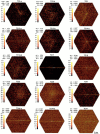Coincidence detection or temporal integration? What the neurons in somatosensory cortex are doing
- PMID: 11264320
- PMCID: PMC6762384
- DOI: 10.1523/JNEUROSCI.21-07-02462.2001
Coincidence detection or temporal integration? What the neurons in somatosensory cortex are doing
Abstract
To assess the impact of thalamic synchronization on cortical responsiveness, we used conditional cross-correlation analysis to measure the probability of neuronal discharges in somatosensory cortex as a function of the time between discharges in pairs of simultaneously recorded neurons in the ventrobasal thalamus. Among 26 neuronal trios, we found that thalamocortical efficacy after synchronous thalamic activity was nearly twice as large as the efficacy rate obtained when pairs of thalamic neurons discharged asynchronously. Nearly half of these neuronal trios displayed cooperative effects in which the cortical discharge probability after synchronous thalamic events was larger than could be predicted from the efficacy rate of individual thalamic discharges. In these cases of heterosynaptic cooperativity, thalamocortical efficacy declined to asymptotic levels when the interspike intervals were >6-8 msec. These results indicate that thalamic synchronization has a significant impact on cortical responsiveness and suggest that neuronal synchronization may play a critical role in the transmission of sensory information from one brain region to another.
Figures









References
-
- Abeles M. Local cortical circuits: an electrophysiological study. Springer; Berlin: 1982.
-
- Abeles M. Corticonic: neural circuits of the cerebral cortex. Cambridge UP; New York: 1991.
-
- Aertsen AMHJ, Gerstein GL, Habib MK, Palm G. Dynamics of neuronal firing correlation: modulation of “effective connectivity.”. J Neurophysiol. 1989;61:900–917. - PubMed
-
- Alloway KD, Burton H. Homotopical ipsilateral cortical projections between somatosensory areas I and II in the cat. Neuroscience. 1985;14:15–35. - PubMed
-
- Alloway KD, Johnson MJ, Aaron GB. A comparative analysis of coordinated neuronal activity in the thalamic ventrobasal complex of rats and cats. Brain Res. 1995;691:46–56. - PubMed
Publication types
MeSH terms
Grants and funding
LinkOut - more resources
Full Text Sources
